Tips and Tricks for Direction Test | Logical Reasoning (LR) and Data Interpretation (DI) - CAT PDF Download
| Table of contents |

|
| What is Direction Test |

|
| Basic Concepts, Tips and Tricks to Solve Direction Test Questions in Reasoning |

|
| Types of Problems on Direction |

|
| Solved Examples |

|
Competitive exams, including those for Bank, SSC, RRB, PSC, often include reasoning questions, which can be categorized into verbal and non-verbal reasoning. Verbal reasoning involves analyzing data presented in paragraphs, such as tables, charts, or codes, to find the correct answer. On the other hand, non-verbal reasoning deals with numbers, alphabets, and logical facts to deduce the appropriate solution. Among the verbal reasoning questions, direction tests are common. This article explores tips and tricks to effectively solve direction test questions in reasoning.
What is Direction Test
Understanding and answering questions related to directions is a common component in various aptitude exams, as it assesses reasoning skills. These questions involve interpreting clues about the eight cardinal directions: north, northeast, east, southeast, south, southwest, west, and northwest. To successfully solve such problems, certain key skills are crucial:
- Clue Interpretation: Ability to comprehend and interpret clues expressed in plain language in terms of directional meanings.
- Logical Ordering: Capability to arrange clues in the correct logical sequence as per the principles of logical reasoning.
- Mapping Concepts: Understanding fundamental mapping concepts, such as identifying basic directions and determining the direction one faces after specific turns (e.g., turning right while heading north).
- Spatial Visualization: Proficiency in visualizing and creating mental representations of the movement or relative positioning of places on a map.
These skills collectively contribute to effectively solving problems related to directions, requiring candidates to mentally visualize and manipulate spatial information based on provided clues.
Basic Concepts, Tips and Tricks to Solve Direction Test Questions in Reasoning
Mastering direction questions can significantly boost your reasoning scores, as they assess both knowledge and the ability to navigate. When tackling these questions, start by creating diagrams using the given data. Familiarize yourself with the four main directions and the cardinal directions before constructing these diagrams. Here are key concepts to grasp for effective problem-solving.
- The four directions are North, South, East, West.
- The four cardinal directions are North-East, North-West, South-East, South-West. If the direction that the person is facing is not mentioned, assume it as North.
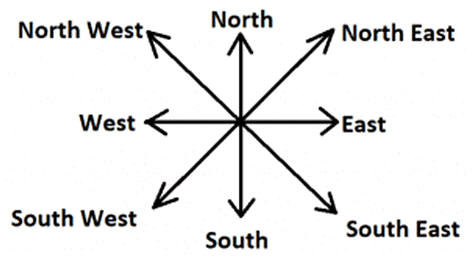
- If a man is standing facing the North, then his shadow will be to the left at the time of sunrise and to the right at the time of sunset.
- There will not be any shadow at 12:00 noon as the sun is vertically overhead.
- If a man stands facing east, his shadow at sunrise will always be towards west.
- If a man stands facing west, his shadow at the time of sunset will always be towards east.
- Pythagoras theorem: If ‘b’ is the base of a right-angled triangle and ‘a’ its height, then the hypotenuse ‘c’ is the root of the squares of sides ‘b’ and ‘a’.
Types of Problems on Direction
Here are some of the types of problems on direction that you can expect in exams:
Q1: Starting from home, a man walks 4 km to the south then turns left and walks 5 km. He takes another left turn and walks 4 km. Find the distance between the man and his home. Find the direction to which he is facing.
Sol: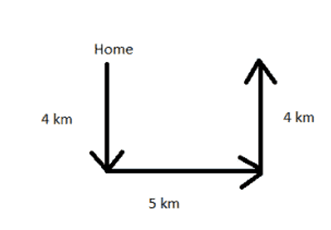
From the diagram, we can understand that he is 5 km away from his home and he is facing North.
Q2: A man, starting from home, walks 4 km to the west and then turns right and walks 3 km. What will be the minimum distance that he needs to cover to reach home?
Sol: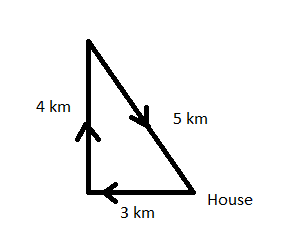 By using Pythagoras Theorem, we can find out the minimum distance that the man needs to cover to reach home.
By using Pythagoras Theorem, we can find out the minimum distance that the man needs to cover to reach home.
As per the figure, the minimum distance is equal to the hypotenuse of the triangle.
Minimum distance = Sq.root of the sum of the squares of 3 and 4
= 5 km.
Q3: Anil was standing facing a pole one morning. The shadow of the pole was formed at the left side of Anil. Which direction is he facing?
Sol: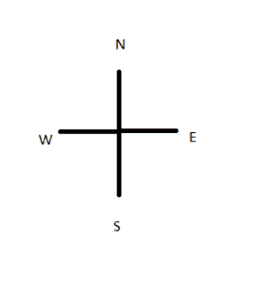 Sun rises in the East and the shadow falls to the West side. It is given that the pole’s shadow falls to the left side of Anil. So he is facing the North side.
Sun rises in the East and the shadow falls to the West side. It is given that the pole’s shadow falls to the left side of Anil. So he is facing the North side.
Q4: A is in the East of B which is in the North of C. If D is in the South of C, then in which direction of B, is D?
Sol: 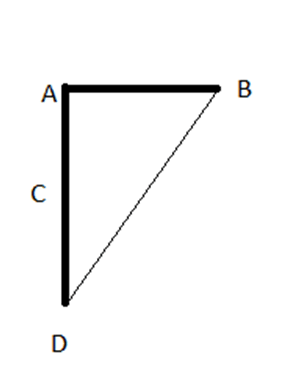 The point D lies to the South -West of B.
The point D lies to the South -West of B.
Solved Examples
Q1: A school bus driver starts from the school, drives 2 km towards North, takes a left turn and drives for 5 km. He then takes a left turn and drives for 8 km before taking a left turn again and driving for further 5 km. The driver finally takes a left turn and drives 1 km before stopping. How far and towards which direction should the driver drive to reach the school again?
(a) 3km towards North
(b) 7 km towards East
(c) 6 km towards South
(d) 6 km towards West
(e) 5 km towards North
Ans: (e)
The driver drove 5 km west, 5 km east, 8 km south and 2+1 = 3 km north. So, he has to travel a distance of 8 – 3 = 5 km north to reach his starting point.
Q2: What is the shortest distance between point F from point A ?
(a) 43m
(b) 4 m
(c) 3 m
(d) 7 m
(e) 5 m
Ans: (e)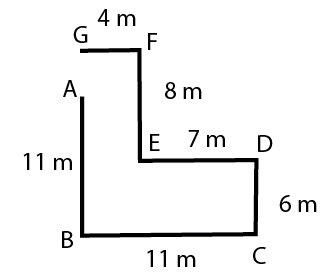
AF2 = 42 + 32
AF = 5
According to the above diagram, shortest distance between F and A will be 5 m. Hence, answer will be E.
Q3: Mohan walked 30 meters towards South, took a left turn and walked 15 meters. He then took a right turn and walked 20 meters. He again took a right turn and walked 15 meters.How far is he from the starting point ?
(a) 95 meters
(b) 50 meters
(c) 70 meters
(d) Cannot be determined
(e) None of these
Ans: (b)
The movement of Mohan is as shown in the diagram below. So, he is 30 + 20 = 50 metres from the original spot.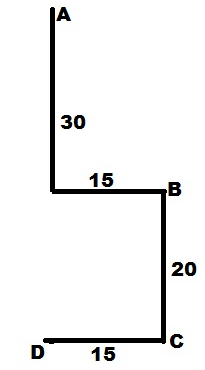
Q4: Town D is towards East of town F. Town B is towards North of town D. Town H is towards South of town B. Towards which direction is town H from town F?
(a) East
(b) South-East
(c) North-East
(d) Data inadequate
(e) None of these
Ans: The position of H can be on either side of D as shown in the diagram below. Unless that is specified, we can’t say if H is to the North East or South East of F.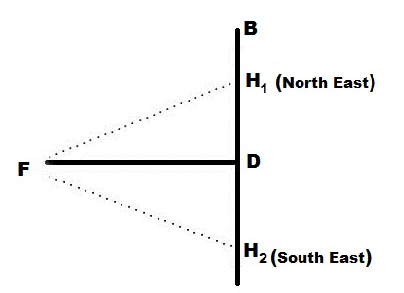
Q5: Gautham starts from point A and rides towards north for 4 kms to reach B, then he takes left turn and travel for 8 kms to reach point C and then he takes another left turn and travel for 12 kms to reach point D. Finally he takes another left turn and travel for another 8kms to reach point E. What is the current position of Gautham with respect to the point A?
(a) 8 kms towards east
(b) 12 kms towards south
(c) 12 kms towards west
(d) 8 kms towards south
(e) Cannot be determined
Ans: (d)
Based on the given information, the path traveled by lakshman could be derived as below.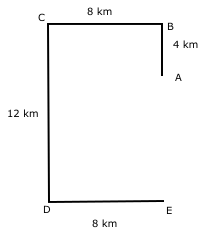
The final point E is 8 km towards south of point A.
So the correct option to choose is D – 8 km towards south.
|
77 videos|180 docs|96 tests
|
FAQs on Tips and Tricks for Direction Test - Logical Reasoning (LR) and Data Interpretation (DI) - CAT
| 1. What are the basic concepts to solve direction test questions in reasoning? |  |
| 2. What are some tips and tricks to solve direction test questions in CAT? |  |
| 3. What are the types of problems that can be encountered in direction test questions? |  |
| 4. How can I improve my performance in direction test questions? |  |
| 5. What are some frequently asked questions (FAQs) related to direction test questions in competitive exams? |  |















